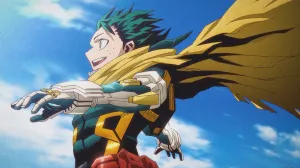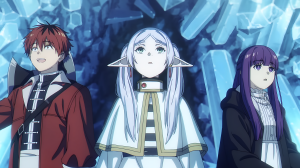
Dark Horse Comics had one of the best year’s of any publisher in comics. Their current lineup is the strongest it has been in over a decade. Despite losing Star Wars, licensed titles like the Aliens, Predators, and Godzilla lines remain very strong and feature some of the best creators working today. Even more impressive are the many creator-owned titles being produced. There’s Mike Mignola’s sprawling collection of Hellboy titles, Matt Kindt’s ongoing series Dept. H, the recent Eisner Award-winning Black Hammer, and many more. It’s hard to pick out a series from Dark Horse’s current lineup as being the best, but not impossible.
Videos by ComicBook.com
That title must go to Usagi Yojimbo.
Usagi Yojimbo is the story of a ronin rabbit in an anthropomorphized feudal Japan, wandering the country and becoming involved in many adventures along the way. The saga was created by master cartoonist Stan Sakai in 1984 and first appeared in an anthology. It wasn’t until 1987 that Miyamoto Usagi received an ongoing series at Fantagraphics for 38 issues. The series was moved to Mirage Comics for 16 issues before finally settling into its final home at Dark Horse Comics, where it has now run for more than 140 issues. Usagi Yojimbo has become one of the standard bearers at Dark Horse alongside the likes of Hellboy, and the current series is one of the most widely beloved in all of American comics.
If you’re not already familiar with Usagi Yojimbo and Stan Sakai, here’s why you should consider checking out the best series at Dark Horse Comics today.

A True All-Ages Story
The phrase “all ages” gets thrown around a lot in entertainment, and it’s typically used as a synonym for “you can give this to kids.” A real all-ages comic shouldn’t just be enjoyable for kids though; it should be enjoyable for readers of all ages. That’s a bar Usagi Yojimbo doesn’t just reach, it leaps it like Superman over a tall building. When researching who reads Usagi Yojimbo, you’ll find studied cartoonists, adult comics fans, and entire classrooms of grade school students. These stories are the real deal when it comes to the concept of four-quadrant storytelling.
A large part of Usagi Yojimbo‘s success as an all-ages comic comes from its willingness to engage with difficult material. In these stories, characters die and bad things occur. Sakai is engaged with the reality of feudal Japan, and that means often brutal conditions for those living in these tales. Sakai doesn’t revel in the violence or misdeeds of the age though. Instead he acknowledges them in a manner that isn’t too disturbing for younger readers just learning about the unfairness of life. The stories also make the feelings evoked more understandable, confronting sadness and anger head on. There are plenty of farces and comedic tales in Usagi Yojimbo, but even when things get dark parents shouldn’t avert their children’s eyes. These comics walk the delicate line that allows for adults and children alike to be moved by their stories. That’s a large part of the magic that is Usagi Yojimbo.

Accessible to Everyone
It’s not enough for a story to be accessible to everyone in terms of content. One of the most difficult elements of comics is simply finding a story that you can afford to read, discover a good starting point, and even find at all. Usagi Yojimbo checks all of these boxes. The series is easy to find at comic book shops, local bookstores, and libraries nationwide. The combination of more than 30 years in publication and a lofty reputation in comics, literary, and educating circles has made its distribution an inevitability. That demand has made affording the series much easier as well. It’s regularly stocked in libraries for anyone who can’t afford to purchase comics or just wants to give the series a try. For those interested in keeping some great reads around their home, there are still a wide array of options. Dark Horse provides oversized collections that pack an enormous amount of material into a $25 package, as well as more standard trade paperbacks and monthly issues. No matter where you’re coming from, you ought to be able to find a way to start reading the series.
That brings up the last question though: Where to start? Unlike most comics that have been around since 1984 or longer, Usagi Yojimbo remains very friendly to new readers. While many of the characters have been around for a very long time, many of the new issues require no prior knowledge to enjoy. Much of what Sakai writes today is designed for brief one- or two-issue tales. A stronger appreciation of character arcs and the history of the series develops from a deep dive, but it’s far from intrinsic to appreciating any new installments. Even the most epic tales from Usagi Yojimbo, like the sprawling “Grasscutter” and “Grasscutter II”, are individual sagas that can be read on their own or within the context of a chronological run. The truth of this series is there’s hardly a wrong place to begin.

A Variety of Exciting Tales
Being able to start anywhere doesn’t mean much if everything is the same though. One of the most exhilarating elements of exploring Usagi Yojimbo is how change is a constant within the series. Sakai speaks regularly in interviews about how he follows his own interests and curiosities to inspire future stories, and he appears to have a very active mind. Within Usagi Yojimbo there are massive sagas of legendary swords and feral demons accompanied by small tales of the traditional building of kites in Japan. Some stories might send shivers down your spine while others will teach you how to replicate classic arts.
Even considering the most recent issues of the series shows the diversity of genre and tone struck within Usagi Yojimbo. Within the past few months, Sakai has told a locked room mystery, explored the preparation of fugu fish, and began a three-part showdown between Usagi and bandits in Usagi Yojimbo #163 in November. The only constant within Usagi Yojimbo is the skill of Sakai’s storytelling and the variety of tales he still has to tell. That’s why Usagi Yojimbo is the best comic published at Dark Horse today.








